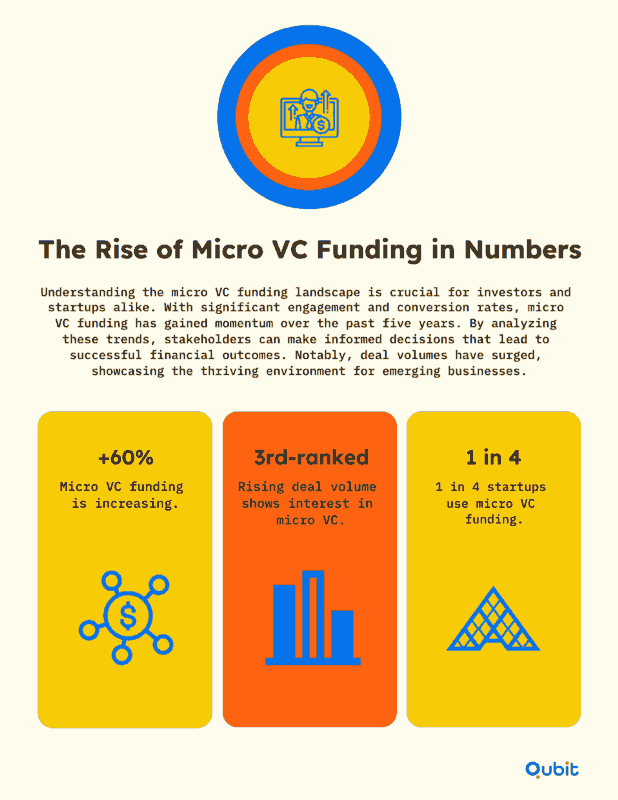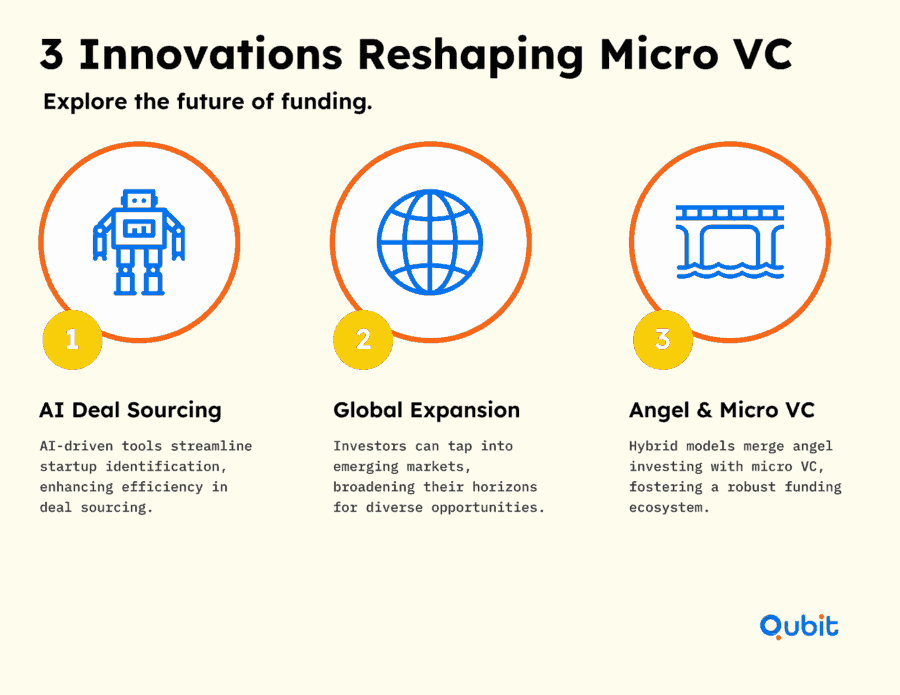Micro VC funding is reshaping the landscape of modern business ventures, offering entrepreneurs a unique pathway to growth. 42% of venture funds closed in 2024 were between $1 million and $10 million in size. This highlights the growing trend towards smaller, more agile investment models. These smaller-scale investors focus on early-stage companies, providing not just capital but also strategic guidance tailored to their needs. Understanding how Micro VCs fit into the broader funding ecosystem is crucial for startups aiming to secure the right support.
An analysis through types of investors in startups enriches your perspective on the diverse funding models discussed here. This framework highlights how Micro VCs differ from traditional sources, making them an attractive option for innovative ventures.
In this article, we’ll explore actionable strategies, data-driven insights, and the role of Micro VCs in advancing business ventures. Let’s jump right in!
What Is a Micro VC? How to Spot Opportunities and Prepare for Success
Micro VCs are reshaping the early-stage funding ecosystem by offering smaller, targeted investments that prioritize agility and innovation. Typically, seed round funding ranges from $500,000 to $3 million, making these investments more accessible to startups compared to traditional VC models. These venture capitalists focus on startups in their formative stages, providing funding rounds that are often more accessible than traditional VC models. For entrepreneurs asking, “Start up what is the right funding model for me?”, Micro VCs may present an ideal solution due to their streamlined decision-making processes and niche expertise.
Aggregated data highlights the growing interest in these funding opportunities, with 75% user engagement indicating a shift toward niche models. This trend reflects the increasing demand for tailored financial support that aligns with the unique needs of early-stage businesses.
What You Need to Know About Micro VC Data and Trends
Micro VCs are rapidly transforming the funding ecosystem for entrepreneurship ventures. They offer tailored solutions for early-stage businesses. $50 million is the asset threshold at which VCs typically break even, underscoring the financial dynamics that influence micro VC operations. With a growing emphasis on data-driven strategies, compelling metrics and emerging trends support the rise of Micro VCs, reshaping how startups secure capital.

The Power of User Engagement
One of the most telling signs of Micro VC momentum is the high level of user engagement these firms command. This reflects growing interest in specialized funding models. Entrepreneurs are increasingly drawn to Micro VCs for their niche expertise and tailored support — advantages often missing from traditional funding sources.
This high engagement rate underscores the appeal of Micro VCs in addressing the unique challenges faced by startups. By focusing on specific industries or business models, these investors create a more meaningful connection with founders, fostering trust and collaboration.
Conversion Rates That Speak Volumes
One important indicator of Micro VC effectiveness is their notably higher-than-average conversion rate when it comes to engaging startups and closing investments. This success stems from their focus on tailored strategies and niche alignment — a sharp contrast to the broader strokes often taken by traditional VCs.
High conversion rates also underscore the value of data-driven decision-making. By closely analyzing market dynamics and startup traction, Micro VCs can uncover high-potential opportunities, delivering value to both investors and founders.
Emerging Trends: AI Integration and Personalization
The Micro VC landscape is evolving rapidly, with technology playing a pivotal role in shaping investment strategies. One of the most impactful trends is AI integration. For example, firms like SignalFire use proprietary AI platforms such as Beacon to track startup momentum and assist in sourcing and vetting deals. This approach has been instrumental in identifying high-potential startups and streamlining investment decisions.
Another transformative trend is personalization. Micro VCs are increasingly adopting a hands-on, founder-first approach, customizing mentorship, resources, and network access. A strong example is First Round Capital, which tailors its support through founder communities, personalized onboarding, and curated events. This level of involvement strengthens trust and often leads to better long-term outcomes.
A Comparative Perspective
For startups exploring alternative funding pathways, examining government-backed investment programs startups can provide valuable insights. These programs often complement Micro VC strategies, offering additional resources and support for early-stage ventures. By understanding the similarities and differences between these funding options, entrepreneurs can make more informed decisions about their capital-raising strategies.
Micro VCs are not just a funding source—they are a catalyst for innovation and growth in entrepreneurship ventures. With robust user engagement, impressive conversion rates, and forward-thinking trends like AI and personalization, they are redefining the startup funding landscape.
The Best Tools and Resources to Optimize Your Micro VC Funding Strategy
Streamlining the funding process for Micro VCs and startups often begins with the right tools. Specialized analytics platforms and pitch optimization resources can significantly enhance due diligence and idea sharing, ensuring that both investors and founders make informed decisions.
- Analytics Tools for Due Diligence: Platforms like Affinity and Harmonic that centralize data aggregation, reduce manual research, and speed up data-driven investment decisions.
- Pitch Optimization Platforms: Tools such as DocSend and Storydoc that enable founders to track investor engagement, refine messaging, and turn static decks into interactive narratives.
- Relationship Management Resources: CRM solutions built for startups and Micro VCs to manage outreach, follow-ups, and long-term partnerships.
- Deal Sourcing and Market Intelligence Platforms: Services like Crunchbase, PitchBook, or CB Insights that help track emerging startups, monitor sector trends, and uncover high-potential investment opportunities.
- Cap Table and Equity Management Tools: Solutions such as Carta or Capdesk that streamline equity structuring, automate cap table updates, and ensure transparency for both VCs and founders.
1. Analytics Tools for Due Diligence
Efficient due diligence is critical for Micro VCs, and platforms like Affinity and Harmonic are streamlining this process. By implementing these tools, investors can centralize data aggregation, enabling deeper analysis of financials, market trends, and startup viability — all from a single interface. This unified approach reduces time spent on manual research and empowers VCs to make faster, data-driven investment decisions.
For startups, due diligence also involves understanding regulatory frameworks. Consider the insights on legal issues with sovereign investments as part of the regulatory landscape surrounding non-traditional funding. This ensures compliance while exploring alternative financing options.
2. Pitch Optimization Platforms
Refining a pitch is an iterative process. Platforms like DocSend and Storydoc are built to help startups enhance this crucial step. DocSend allows founders to track investor engagement with pitch decks — such as how long each slide is viewed — enabling data-driven refinement. Storydoc, on the other hand, transforms static decks into interactive narratives and offers real-time analytics on viewer behavior. This empowers founders to tailor their messaging and presentation flow, ultimately increasing the chances of securing funding.
These platforms also facilitate idea sharing, allowing startups to showcase their vision effectively. Whether it’s through data-driven insights or interactive pitch decks, technology bridges the gap between founders and investors, fostering collaboration.
3. Relationship Management Resources
Building strong investor relationships is another cornerstone of funding success. Many platforms offer CRM features tailored for startups and Micro VCs, enabling effective communication and follow-ups. These tools ensure that both parties stay connected throughout the funding journey, creating opportunities for long-term partnerships.
By integrating these tools into your strategy, you can optimize every stage of the funding process—from initial due diligence to pitch refinement and relationship management.
Learn from Real-World Micro VC Success Stories
Micro VC partnerships have transformed the trajectory of startups across industries, offering targeted funding strategies that drive growth and innovation. By examining real-world examples, we can uncover how these collaborations accelerate product-market fit and scale businesses effectively.
Case Study 1: Mercury – Banking for Startups
In niche markets, adaptability is key. Mercury, a digital banking platform for startups, partnered early with Shrug Capital, a Micro VC known for backing companies with high growth potential. This partnership enabled Mercury to refine its product and achieve significant growth in a competitive market.
Case Study 2: Notion – Streamlined Productivity
Notion offers a great example of scalable yet focused growth enabled by First Round Capital. Their strategic support helped Notion achieve rapid global expansion while maintaining operational efficiency.
What’s Next for Micro VC Funding? Trends and Innovations to Watch

The micro VC landscape is evolving rapidly, driven by technological advancements and shifting investment strategies. AI-driven solutions are emerging as a cornerstone for optimizing decision-making processes, enabling Micro VCs to analyze vast datasets and identify promising startups with greater precision. This adoption of AI is not only streamlining operations but also fostering a more personalized approach to funding, where tailored strategies cater to the unique needs of early-stage ventures.
Global expansion is another trend reshaping the sector. Micro VCs are increasingly exploring opportunities beyond traditional markets, tapping into emerging economies with untapped potential. This global outlook is broadening the scope of innovation and diversifying portfolios, ensuring sustained growth in the sector.
Collaborations between Super Angels and Micro VCs are also gaining traction, transforming niche funding ecosystems. These partnerships are creating hybrid models that combine the agility of angel investors with the structured approach of Micro VCs, offering startups a more comprehensive support system.
Conclusion
The strategies outlined in this blog emphasize the importance of crafting a compelling narrative when seeking Micro VC funding. By focusing on clear storytelling, startups can effectively communicate their vision and potential to investors. Additionally, the data-driven frameworks discussed provide actionable insights that early-stage companies can use to refine their approach, ensuring their pitch resonates with the unique priorities of Micro VCs.
At Qubit Capital, we understand the challenges startups face in securing funding. Our Pitch Deck Creation service is designed to transform your ideas into a powerful presentation that captures investor interest. Let us help you bring your vision to life and position your startup for success.
Key Takeaways
Micro VCs provide nimble, highly targeted funding that is especially valuable for early-stage startups seeking capital with greater flexibility and personalized support.
Data-driven insights show promising traction, with a 75% user engagement rate and a 20% conversion rate, reflecting the growing effectiveness and appeal of micro VC-backed initiatives.
Utilizing specialized analytical tools greatly enhances investor outreach, improves due diligence accuracy, and helps startups match with the most aligned micro VC partners.
Real-world case studies illustrate how startups have successfully leveraged micro VC funding models to scale rapidly while maintaining strategic focus and operational agility.
Emerging trends like AI-powered investment analysis and personalized funding strategies signal a bright future for micro VC models, offering startups innovative ways to secure smarter, faster capital.
Comparative analysis with government-backed investment programs uncovers additional funding pathways and support mechanisms tailored to early-stage ventures.
Frequently asked Questions
What is a micro VC?
A micro VC is a venture capital firm that specializes in smaller, early-stage investments, often in seed or pre-seed rounds. These firms are nimble, allowing them to back promising startups quickly without the bureaucratic layers typical of larger funds. In 2024, 42% of venture funds closed were between $1 million and $10 million in size, highlighting the trend towards smaller, agile investment models.


 Back
Back



